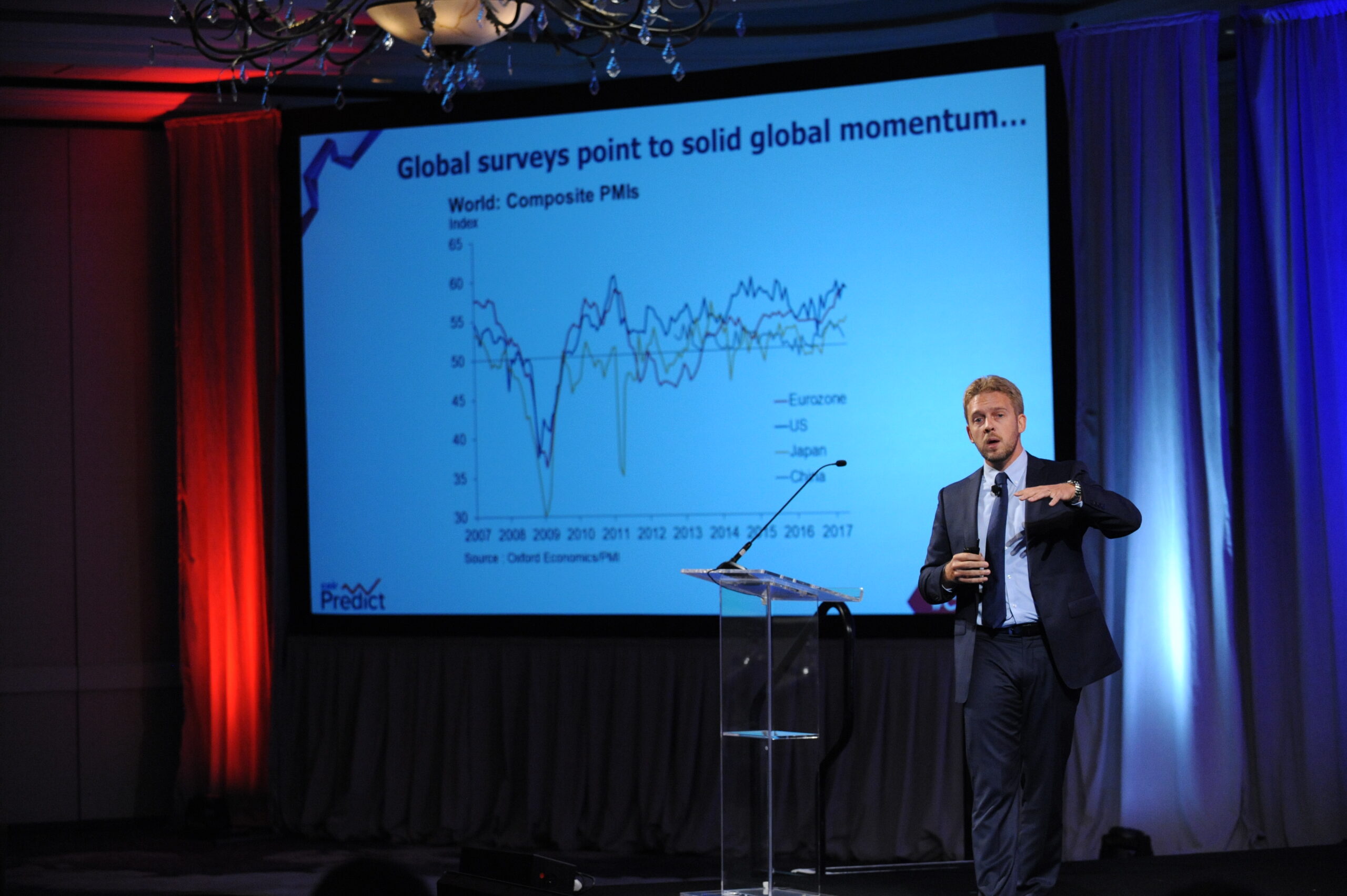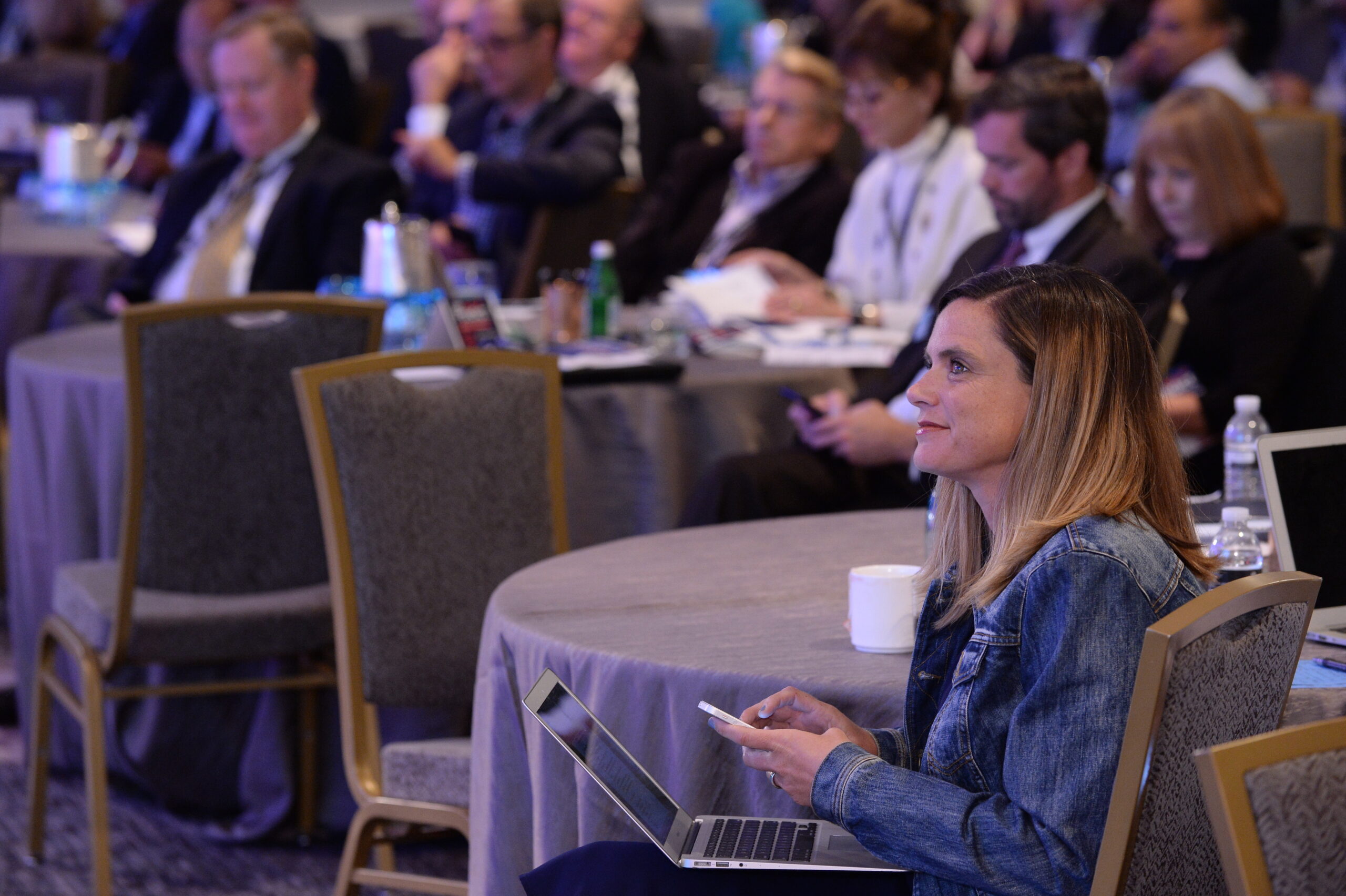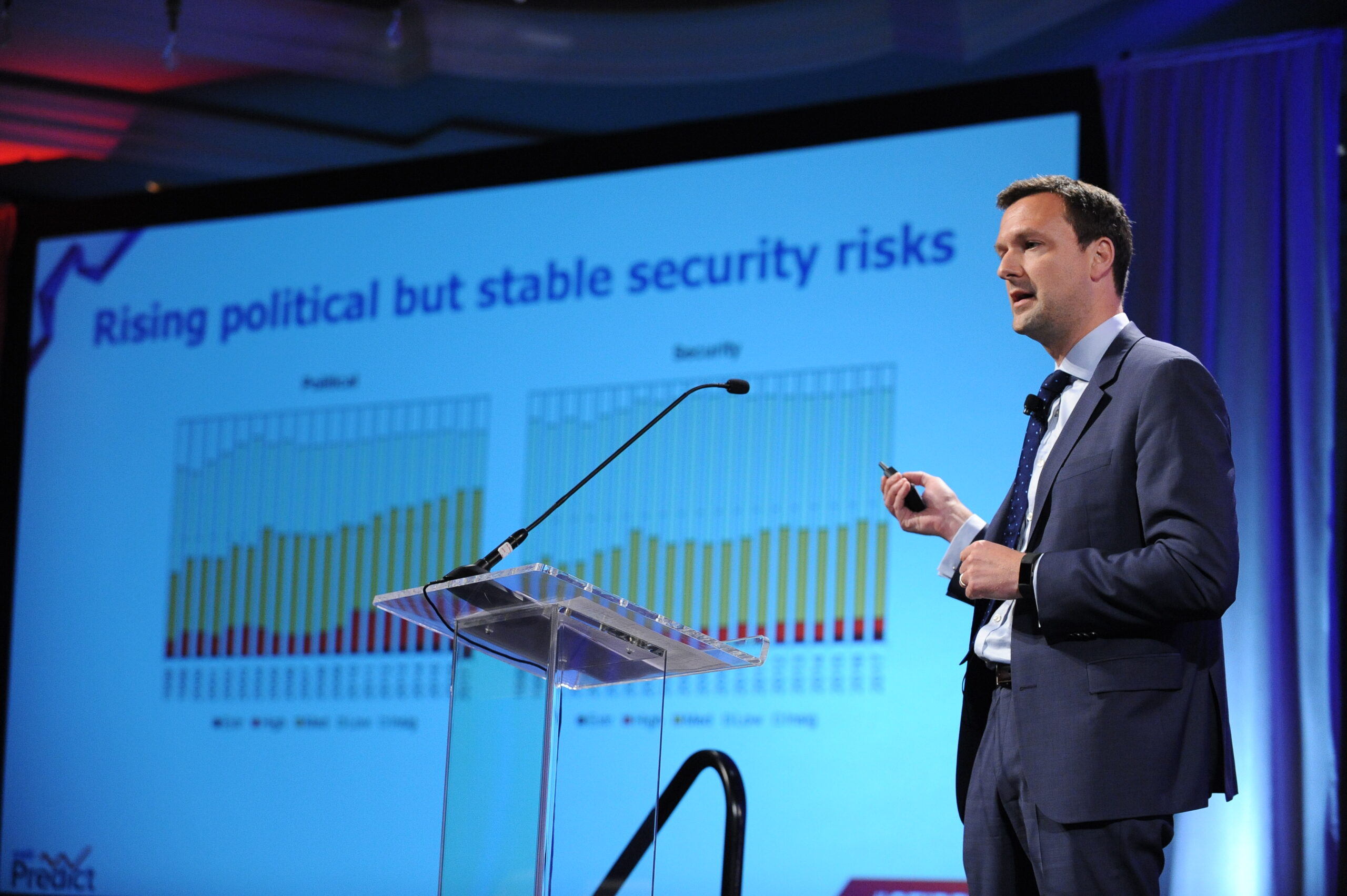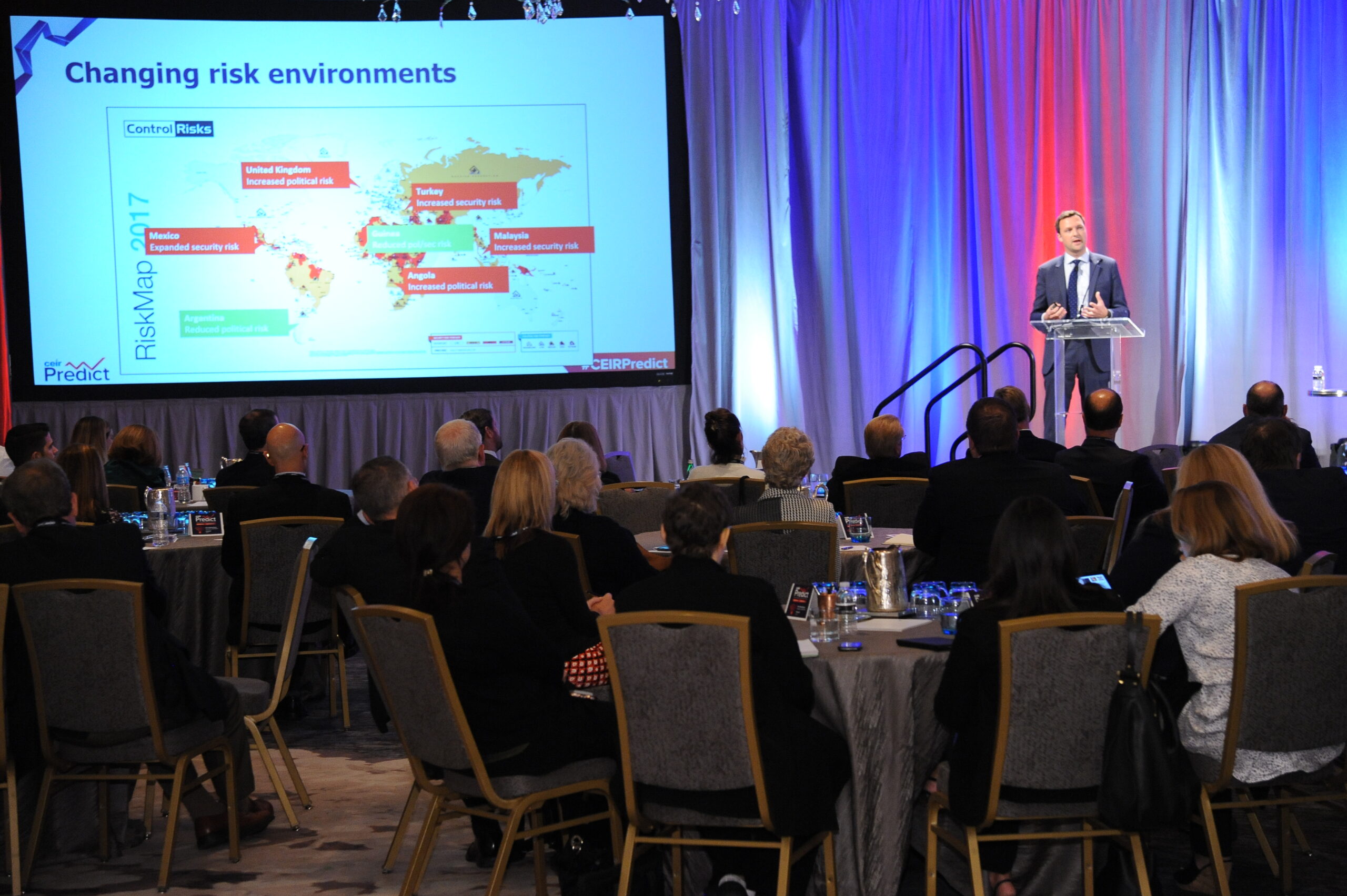Thank you to session partner, PSAV!

Two economists walk into a room full of exhibition and event c-suite executives…no, this isn’t the start of a joke. Gregory Daco, Chief U.S. Economist of Oxford Economics and Iain Donald, Senior Partner at Control Risks gave us a rundown of the micro and macro factors and their likely impact on our exhibitions and events industry. So, why is this important?
[wpvideo cs4zzjok]
Global Economic Landscape
More than a year into the Trump administration, tumultuous policies and unpredictable, erratic behavior have been the norm in the U.S. While we experience the ups and downs of the administration, the rest of the world has watched and their economies have strengthened.

Oxford Economics’ Forecast Highlights:
- World GDP growth accelerating to 2.8% in 2017 and predicted to be at 3.0% in 2018.
- Global surveys point to buoyant activity. Momentum appears to be sustainable from 2017 to end of 2018.
- U.S. economy will remain in 2% growth mode with inflation remaining below the Fed’s 2% target
- 2% is faster than the economy’s potential.
- If the economy is growing faster than the potential, this means that the output gap is closing and improving the livelihoods and the incomes of individuals and companies
- China continues to enjoy growth. Economic policy is shifting from focus on exports market to stimulating in-country consumer demand among its growing middle class. A wise change in light of anti-global trade.
- Euro economy is gaining momentum. The European Union is outperforming expectations and enjoying best growth rates in over a decade. However, a strengthening Euro could hurt travel and trade to the region.
- Emerging markets growth in Latin America improving though political risks still abound.
Economic Reaping of the U.S.
Despite an uncertain outlook for the future, the U.S. economic activity remains solid. Consumer confidence remains strong. Employment continues to grow strongly. Wage growth is gradually picking up. There’s a stronger growth in exports and business. The travel industry has been outpacing the economy and the trend appears to continue.

Many economic charts report that the U.S. economy is growing at 6%. However, this is based on soft data readings, which means that these data points partly contain expectations that we had believed would be fulfilled by the current administration. Based on hard data readings, the U.S. economy is growing at a 2%. Although the growth percentage is not as high as expected, Daco provides some encouragement. He will “take 2% any day if it’s sustainable.” As long as the U.S. economy is growing, isn’t that all that matters?
Let’s reap the benefits, but don’t be overly optimistic. As we have observed, the good doesn’t always last.
Trouble on the Horizon
Polling the room, Daco announced that our biggest concern for 2018 was policy error in the U.S. About 60% of us had a negative outlook on the U.S. policy mix for growth. The U.S. policy mix, thus far, has not been pro-growth. There is still massive uncertainty, the rise of trade protectionism and strong anti-immigration views that appear to challenge higher growth.

It is no surprise that immigration is crucial and has been a cornerstone for the growth of the U.S. economy. Immigration fuels the economy and greases the wheels of the labor market. International students contributed $30-35 billion to the U.S. economy in 2015. If the administration decides to eradicate DACA (Deferred Action for Childhood Arrivals), that would be a cumulative hit of $100 billion.
Tourism in the U.S has declined. Travel demand into the U.S. has been down since the 2016 elections. As Daco impeccably explains, “if we restrain immigration, we’re essentially shooting ourselves in the foot.” U.S. policies are having the country lose out on opportunities and weakening global relations, which trickles down to the exhibition and event industry. International attendees may not attend your show because of the U.S.’s unwelcoming policies to international travelers, which takes a hit on your show revenue.
Risky Business
As the saying goes, “there’s no reward without risk.” Unfortunately, there doesn’t seem to be a foreseeable reward for the risks put in place by the administration. Donald explains that there’s rising political risks, but stable security risks. Political risks include but not limited to government actions that may disadvantage business, policy changes, hostile government intervention, etc.

Just as trade shows foster relationships, Donald points out that the “world is really more connected from a financial, communications and cultural perspective than it ever has been before.” However, the current U.S. administration appears to move away from globalization and focus more on making “America Great Again,” by imposing trade protections.
As the U.S. retreats from advocating global trade, a new multilateral, regional trade environment is forming. Are we ready for that? The trade protections in place by the U.S. appear to only spell disaster. Protectionism hurts whoever starts the fights and the U.S. runs the risk of losing 1% of GDP.
Imagine our industry’s impact on the U.S. economy. The B2B exhibition and event industry contributed $80 billion to the U.S. GDP in 2016. If the industry lost 1%, we would lose $800 million. The role the U.S. plays in the world greatly impacts the exhibitions and events industry.

Control Risks’ Top 5 Risks
- U.S. Disruption
- Despite strong equity markets, there is nervousness and caution in private capital markets. Geopolitically, there is nervousness in light of U.S. disengagement. Today’s world is becoming nationalist and multipolar.
- EU Politics
- Brexit is expected to be more harmful to the UK than the European Union.
- Great Power Competition
- China’s succession of leadership process suggests power transition that will result in more assertive behavior moving forward.
- The threat of North Korea and their nuclear arms is rising and could disturb the world power play.
- Volatile Regulation
- Patchwork of regulation at national level is making it harder and more expensive to comply with regulations stemming from data and security.
- Terrorist Fragmentation
- Terrorism is now related to workplace violence.
- Terrorism is likely to move to transnational terrorism. Returning foreign fighters from failed Islamic State in Iraq and Syria coupled with readily available online material make lone-wolf attacks more likely to occur. Western Europe is most vulnerable due to location proximity.
Final Thoughts
Many factors are in play for trade show organizers on the successful future of their shows. Executives need to look at the bigger picture and expand their focus beyond their shows. We have to pay attention to external factors that could affect not only our show, but our entire industry. For our industry to continue thriving, understand the macro and micro factors that could disrupt and change the course of the exhibitions and events industry. The viability of your show depends on it.
For this and other insightful commentary on the future of exhibitions, we invite you to apply for registration for the 2018 Predict conference, taking place on 13-14 September at the MGM National Harbor in Oxon Hill, MD.
